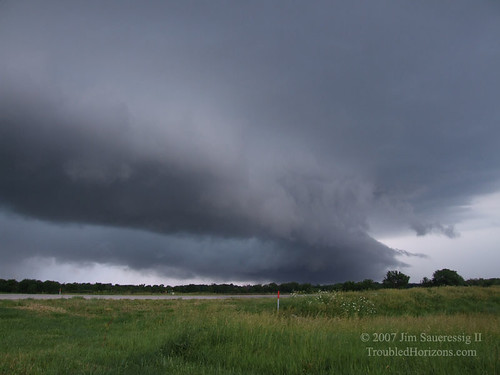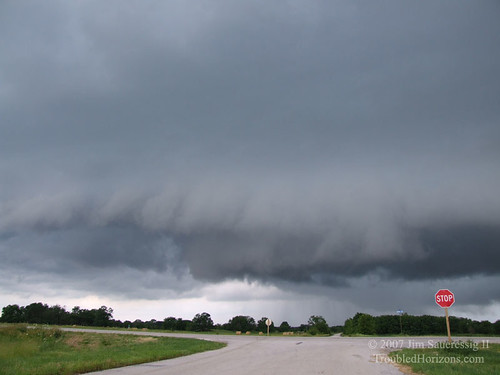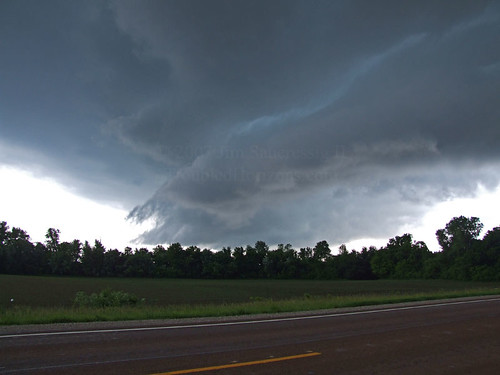Jim Saueressig
EF5
First of all a disclaimer, I am self taught and have no official college training in meteorology so I can be wrong as I am no expert
I have had an issue nagging at me for a few years now here and in other forums with peoples identification of a wall cloud. I have seen so many shelf clouds identified as wall clouds that I myself am wondering if I am misidentifying a few. After yesterday I find myself nagged into this post.
From Wikipedia, the free encyclopedia:
Wall Cloud
Genesis
Arcus cloud, aka shelf cloud:
Formation:
Roll cloud
Shelf cloud
Wall cloud vs. shelf cloud
A shelf to me: (I have seen this called a wall many times)

The only time I really questioned a shelf was the one posted above that had a rotational area in the middle (picture above is right of this area) where the cell started rebuilding a stronger cell ahead of the original cell that created the shelf and may have indeed been a wall forming by coincidence in the middle of the existing shelf. You can see the hail core in and behind it. I shot this East of the storm it was a right mover heading at me.

This was the original cell West of and 20 minutes earlier than the pics above.

I would like to see some discussion with photos and examples. ( I had more but were lost in my HD crash)
I have had an issue nagging at me for a few years now here and in other forums with peoples identification of a wall cloud. I have seen so many shelf clouds identified as wall clouds that I myself am wondering if I am misidentifying a few. After yesterday I find myself nagged into this post.
From Wikipedia, the free encyclopedia:
Wall Cloud
A wall cloud, or pedestal cloud, is a cloud formation associated with thunderstorms. It is a marked lowering typically beneath the rain-free base (RFB) portion of a deep cumulus cloud (normally cumulonimbus but on occasion cumulus congestus), and indicates the area of primary and strongest updraft which condenses into cloud at altitudes lower than that of the ambient cloud base. Most strong tornadoes form within wall clouds.
Genesis
Wall clouds are caused by the ascending and converging inflow air of the updraft ingesting moist, rain cooled air from the normally downwind downdraft. In supercells this is the forward flank downdraft {FFD}. Since temperature tends to be reduced and dew point (moisture content) increased, as the updraft entrains this air, saturation occurs sooner as the air rises. Wall clouds may form as a descending of the cloud base or may form as rising scud consolidates and organizes.
Arcus cloud, aka shelf cloud:
An arcus cloud is a low, horizontal cloud formation associated with the leading edge of thunderstorm outflow, or occasionally with a cold front even in the absence of thunderstorms. Roll clouds and shelf clouds are the two types of arcus clouds, slight variations in their generation and look being the difference.
Formation:
Cool, sinking air from a storm cloud's downdraft spreads out across the surface with the leading edge called a gust front. This outflow undercuts warm air being drawn into the storm's updraft. As the cool air lifts the warm moist air, water condenses creating a cloud which often rolls with the different winds above and below
Roll cloud
A roll cloud is a low, horizontal, tube-shaped, and relatively rare type of arcus cloud. They differ from shelf clouds by being completely detached from the thunderstorm base or other cloud features. Roll clouds usually appear to be "rolling" about a horizontal axis. They can be a sign of possible microburst activity.
Shelf cloud
A shelf cloud is a low, horizontal wedge-shaped arcus cloud. Unlike a roll cloud, a shelf cloud is attached to the base of the parent cloud (usually a thunderstorm). Rising cloud motion often can be seen in the leading (outer) part of the shelf cloud, while the underside often appears turbulent and wind-torn.
Occasionally people seeing a shelf cloud may believe they have seen a wall cloud. This is a common mistake, since an approaching shelf cloud appears to form a wall made of cloud. Generally speaking, a shelf cloud appears on the leading edge of a storm, and a wall cloud will usually be at the rear of the storm.
Wall cloud vs. shelf cloud
Occasionally people see a shelf cloud and think they have seen a wall cloud, which is an easy mistake, since an approaching shelf cloud appears to form a wall made of cloud. Generally, a shelf cloud appears on the leading edge of a storm, and a wall cloud will usually be at the rear of the storm, though small rotating wall clouds associated with mesovortices can occur within the leading edge on rare occasion. Wall clouds will tend to slope in, or toward the precipitation area, whereas shelf clouds as outflow clouds will jut outward from the storm. Wall clouds are inflow features with (often warm) air moving towards them whereas as shelf clouds are an outflow feature with cool air moving away from the storm, often as a gust front.
A shelf to me: (I have seen this called a wall many times)

The only time I really questioned a shelf was the one posted above that had a rotational area in the middle (picture above is right of this area) where the cell started rebuilding a stronger cell ahead of the original cell that created the shelf and may have indeed been a wall forming by coincidence in the middle of the existing shelf. You can see the hail core in and behind it. I shot this East of the storm it was a right mover heading at me.

This was the original cell West of and 20 minutes earlier than the pics above.

I would like to see some discussion with photos and examples. ( I had more but were lost in my HD crash)







